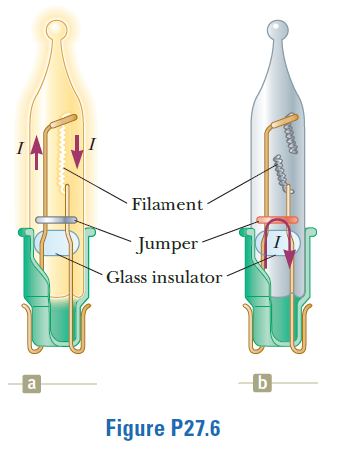Consider strings of incandescent lights that are used for many ornamental purposes, such as decorating Christmas trees. Over the years, both parallel and series connections have been used for strings of lights, and the bulbs have varied in design. Because series-wired lightbulbs operate with less energy per bulb and at a lower temperature, they are safer than parallelwired lightbulbs, where each bulb operates at 120 V. To prevent the failure of one lightbulb from causing the entire string to go out for the bulbs wired in series, a new design was developed. 27.6a shows one of these types of miniature lightbulb designed to operate in a series connection. When the filament breaks in one of these lightbulbs, the break in the filament represents the largest resistance in the series, much larger than that of the intact filaments. As a result, most of the applied 120 V appears across the lightbulb with the broken filament. Inside the lightbulb, a small jumper loop covered by an insulating material is wrapped around the filament leads. When the filament fails and 120 V appears across the lightbulb, an arc burns the insulation on the jumper and connects the filament leads, as shown in 27.6b. This connection now provides a low-resistance path through the lightbulb, even though its filament is no longer active, and the voltage across the bulb drops to zero. All the other lightbulbs not only stay on, but they glow more brightly because the total resistance of the string is reduced and consequently the current in each remaining lightbulb increases. Suppose you have a string of 48 bulbs, each one with a resistance of 8.00 Ω. Assume the resistance of a bulb with its filament broken drops to zero. Suppose that a bulb becomes dangerously warm, so that it could set something on fire, if it receives a power of 1.75 W. How many bulbs can fail before the string of lights becomes dangerous?

Trending now
This is a popular solution!
Step by step
Solved in 4 steps with 4 images









